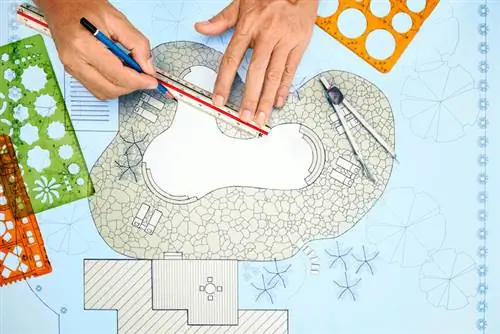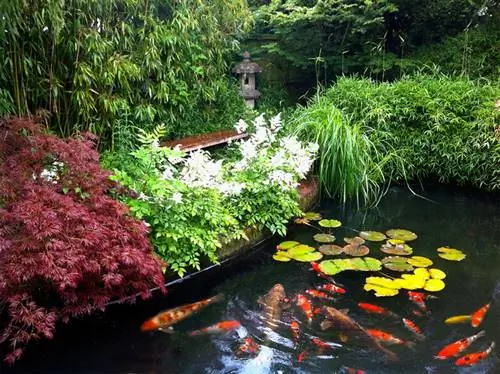- Author admin [email protected].
- Public 2023-12-16 16:46.
- Last modified 2025-01-23 11:21.
Pond liners are generally ordered directly in the required dimensions and are already welded together to this size by the manufacturer. How to determine the correct dimensions and calculate the required size of the pond liner, and what you need to consider, can be found in this article.

How do you calculate the correct size of the pond liner?
To calculate the pond liner required, add twice the maximum depth and 80 cm as an overlap to the maximum length and width of your pond. For more precise results, measure individual detailed dimensions and create grid plans if necessary.
Basic measurements
The three basic dimensions that play a role in a garden pond are:
- Length
- Width and
- Depth of the pond
The future intended use should also be taken into account when planning.
Example fish pond
For example, ponds with fish stock should always be at least 1 m deep. In addition, the fish you want to keep in it should also have enough space. How much space this requires depends on the type of fish.
Koi, which can often reach a considerable body length of up to 80 cm, of course also need enough space in the pond. If, on the other hand, you use the easy-care Moderlieschen, which are only 9 cm long and like to move in schools of around 15 animals, you need a little less space (but still enough so that the fish can gather in a school in a species-appropriate manner).
In this case, find out beforehand about the dimensions your pond should have and plan accordingly. The size of the pond liner then results from the dimensions of the pond.
Detail dimensions for the film
A pond is not the same depth in all places, but has an embankment on each side. To take this into account, you have to calculate a little more precisely. We will show this with a small example.
Themaximum lengthof our garden pond should be 5 m. Themaximum width(at the widest point) should be 4 m. At the deepest point our pond should be 1.50 meters deep.
Now the following formulas are used:
Film length=Maximum length + 2 x maximum depth + overlap
Film width + 2 x maximum depth + overlapYou can always calculate around 80 cm as an overlap. This means that edge development and capillary barriers are already taken into account.
This results in the following required film size for our pond dimensions:
5 m + (2 x 1.50 m) + 0.8 m=8.80 m as film length4 m + (2 x 1.50 m) + 0.8 m=7, 80 m as film width
Be aware: However, this calculation is only an approximation. The embankment stretches in particular are recorded very imprecisely.
Measure detailed dimensions
If you want very precise lengths and widths of your film, you can also easily measure your pond:
Lay a tape measure across the embankment and through the entire pond, also taking into account the capillary barrier on both sides. Your tape measure will give you a very accurate indication of how long and how wide your film needs to be.
grid dimensions
In order to calculate the liner requirements more precisely, especially for irregularly shaped ponds, you can also create a grid plan. This will help you to estimate the liner requirements reasonably well even where the length or width of the pond varies.
When determining the grid dimension, an imaginary center line is simply drawn through the pond. The width of the pond in this section is then measured at regular intervals starting from the center line to the left and right and entered on the plan as a grid width.
Especially with irregularly shaped ponds, this helps to get an idea of how much foil you actually need and how wide the pond is at which point. When measuring, don't forget to take into account the length of film required for the edge design at each measuring point (at least 50 cm on each side, preferably a little more)
As a measuring distance, it is best to usethe width of a film strip offered by the manufacturer This helps the manufacturer to proceed in a planned manner when producing the film and welding the films together. Don't forget to mark the position of the center line on your grid plan and label the distances to the left and right separately!
Restrictions on pitch films
You should remember that films that are made for you in grid dimensions cannot be claimed later by the manufacturer.
In addition, these films often come with a small surcharge (usually around 10%) on top of the actual price per square meter for the garden pond liner. Due to the grid size ordering, they always come out a little more expensive. This is usually worth it because of the lower waste compared to a rectangular film, which you don't have to pay for in this case.
Complex grid dimensions
With ponds, it can happen that the side walls do not rise evenly, but are laid out in a terrace shape. Creating a so-called bank terrace is already recommended for most ponds.
To take these dimensions into account, you can expand your grid plan accordingly. Mark the width of each terrace and indicate the corresponding depth for each section. This allows you to calculate the foil more precisely, as you need a little more foil width and length than with a normal sloping slope.
Tip
For very complicated pond shapes with several terraces, to be on the safe side, you should leave the calculation to the manufacturer who has more experience. Ask if you can just hand over the pond sketch.






